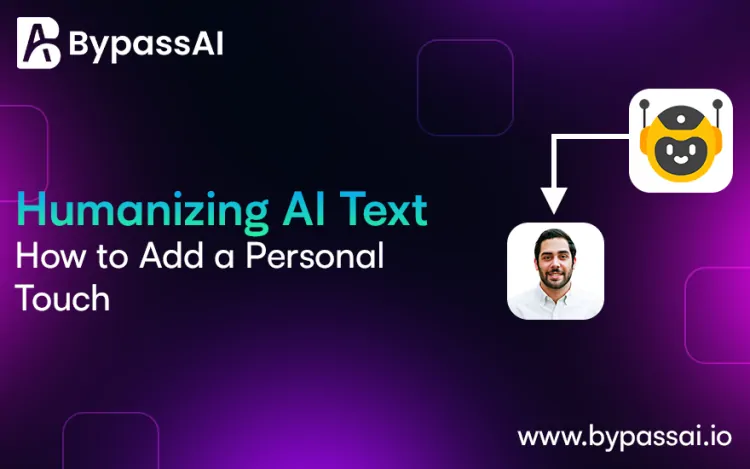Humanizing AI Text: How to Add a Personal Touch
In a world where artificial intelligence is increasingly shaping our digital interactions, adding a personal touch to AI-generated content has become essential.

In a world where artificial intelligence is increasingly shaping our digital interactions, adding a personal touch to AI-generated content has become essential. Whether you're drafting an email, writing a blog post, or crafting a marketing message, making AI text feel more human can significantly enhance engagement and relatability. Let’s dive into the art of humanizing AI text and explore practical ways to make your content resonate with real people.
What Does It Mean to Humanize AI Text?
Humanize AI Text is about making machine-generated content feel like it’s coming from a real person. This involves adding nuances, emotions, and personal touches that AI often lacks. By doing so, you can bridge the gap between robotic efficiency and human warmth.
Why Is Humanizing AI Important?
Humanizing AI text helps to:
-
Build Trust: People connect better with content that feels personal and genuine.
-
Enhance Engagement: Readers are more likely to interact with content that resonates on a human level.
-
Improve Conversion Rates: Personalized content can lead to higher conversion rates in marketing.
The Challenges of AI-Generated Content
AI has come a long way, but it still faces several challenges in generating content that feels truly human. These include:
-
Lack of Emotional Depth: AI often struggles with conveying complex emotions.
-
Monotony: AI-generated text can sometimes come across as repetitive or formulaic.
-
Contextual Understanding: AI may miss subtle contextual cues that give text a personal touch.
Strategies to Humanize AI Text
1. Inject Personality into Your Writing
Personal pronouns like “I,” “we,” and “you” can make your content feel more conversational and less robotic. For instance, instead of saying, “One should consider this option,” try, “You might find this option worth considering.”
2. Use Conversational Language
A conversational tone is more engaging and relatable. This means:
-
Avoiding jargon or overly formal language.
-
Using contractions like “don’t” instead of “do not.”
-
Keeping sentences short and easy to understand.
3. Add Personal Stories and Anecdotes
Sharing personal stories or anecdotes can make your content feel more authentic. For example, if you’re writing about productivity tips, share a brief story about how a particular method worked for you.
4. Employ Rhetorical Questions
Rhetorical questions can make readers feel involved and encourage them to think. For instance, “Have you ever wondered why some productivity hacks just don’t work for you?”
5. Incorporate Analogies and Metaphors
Analogies and metaphors can simplify complex ideas and make your content more relatable. For example, you might describe the process of writing an engaging blog post as “crafting a story that draws readers in like a good novel.”
6. Show Empathy and Understanding
Demonstrating empathy can make your content more relatable. For example, instead of simply listing benefits of a product, acknowledge the reader’s potential pain points and how the product can address them.
Examples of Humanized AI Text
Before:
“Improve productivity by using time management techniques.”
After:
“Ever feel like there’s never enough time in the day? Try these time management techniques to take control of your schedule and boost your productivity.”
Tools and Techniques for Humanizing AI Text
1. Editing and Proofreading Tools
Tools like Grammarly and Hemingway can help refine your text, making it clearer and more engaging. They can catch awkward phrases and suggest improvements.
2. Writing Assistants
AI writing assistants, like Jasper or Copy.ai, can help generate more personalized content by incorporating user inputs and preferences.
3. Feedback from Real Readers
Getting feedback from actual readers can provide insights into how well your content resonates and where it might need more human touch.
Case Studies: Successful Humanized AI Text
1. Marketing Campaigns
Companies like Coca-Cola use personalized messaging in their marketing campaigns to create a more engaging customer experience. For instance, their “Share a Coke” campaign replaced the brand’s name with popular names, making the product feel more personal.
2. Customer Service
Chatbots that use a friendly and conversational tone, like those employed by companies such as Sephora, can make interactions feel more human and less robotic.
Tips for Maintaining Consistency
1. Develop a Brand Voice
Having a consistent brand voice helps in maintaining a personal touch across all content. Define your tone and style guidelines to ensure uniformity.
2. Regular Training and Updates
Continuously train your AI tools to understand the nuances of your brand’s voice and update them based on feedback and performance.
Future Trends in Humanizing AI Text
1. Improved Emotional Intelligence
As AI technology advances, future tools may better understand and replicate human emotions, leading to even more personalized and empathetic content.
2. Enhanced Personalization
Increased data integration and analytics will allow AI to create content that is even more tailored to individual preferences and behaviors.
Conclusion
Humanize AI isn’t just about adding a personal touch; it’s about creating content that genuinely connects with readers. By injecting personality, using conversational language, and incorporating personal stories, you can make AI-generated content feel more like it’s coming from a real person. Embrace these strategies to bridge the gap between AI efficiency and human warmth.
What's Your Reaction?













